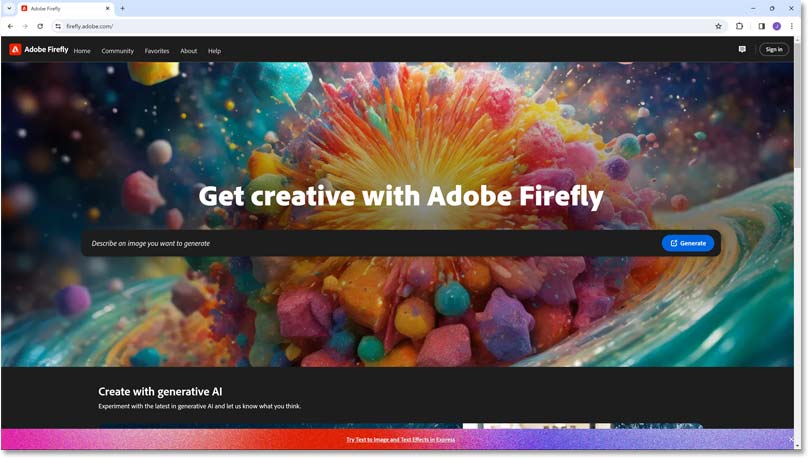
Using Structure Reference and Style Reference in Adobe Firefly
Learn how to control the composition and visual style of Adobe Firefly's AI-generated images by using existing images as a reference.
Download the PDF: Using Structure and Style Reference in Adobe Firefly
Adobe Firefly (the generative AI technology that powers Photoshop’s Generative Fill) has an amazing new feature in its text-to-image module called Structure Reference (also called Structure Match) which enables you to control the composition of your AI-generated image by using an existing image as a reference.
Structure
refers to the size, shape and arrangement of the various elements in the image. Firefly looks for the outlines and depth in the reference image and matches them to the new image to keep the composition similar.
Also in Firefly’s text-to-image module is Style Reference (or Style Match) which can match the visual style of a reference image (the colors, lighting, textures, mood and theme). By combining Structure Reference and Style Reference with your prompts in Adobe Firefly, you can reduce the frustrating randomness of text-to-image generation and gain much more control over the result. Here’s how they work.
How to access Adobe Firefly
To get started, open your web browser and go to the Adobe Firefly website (firefly.adobe.com). Then sign in to your Adobe account.
You'll need a free or premium Firefly plan or an active Creative Cloud subscription to use Adobe Firefly.

Let's get started!
How to use Structure Reference in Adobe Firefly
Let’s start by using Structure Reference to control the composition of your AI-generated image. We’ll then use Style Reference to control the visual style.
Step 1: Enter a prompt and click Generate
First you need to enter a prompt and let Adobe Firefly generate an initial result.
I’m a big fan of old science fiction movies. So for my prompt, I’ll enter An astronaut wearing a retro spacesuit, posing in front of a vintage rocket ship
.

Then click the Generate button.

After a few seconds, Adobe Firefly generates four initial results based solely on your prompt, which means you get what you get. In my case, Firefly got the general idea of what I’m looking for. There’s an astronaut and a rocket ship, so that’s good.
But now we can use Structure Reference to gain more control over the composition, which we’ll do next.

Step 2: Upload a structure reference image
Look for the new Structure category in the column along the left and click the Upload image button. Then select the image you want to use as the reference.

I’ll use this image because I want Adobe Firefly to match the same location, size and pose as the man in this photo.

Firefly will ask you to confirm that you have the rights to use the image. Assuming you do, click Continue.

Back in the Structure options, the uploaded image appears in the Reference thumbnail.

Also, a Structure reference tag appears in the Prompt area along the bottom. Hovering your mouse cursor over the tag displays the image being used as the reference.

Step 3: Adjust the Strength amount
Use the Strength slider to adjust how closely the generated image should match the structure of the reference image. There are three settings (Low, Medium and High).
Medium is the default but I’ll choose High.

I’m also going to change a couple of other settings before I continue.
- Under General Settings, I’ll change the Aspect ratio from Square (the default) to Landscape (4:3).
- Under Content Type, I’ll choose Photo so the results look more realistic and less like illustrations.

Step 4: Click Generate
Click the Generate button in the Prompt area to generate four new versions of the image.

This time, thanks to Structure Reference, Adobe Firefly was able to match the composition of my reference image in all four generated results.
So far so good. But now let’s take it further with Style Reference.

How to use Style Reference in Adobe Firefly
We’ve matched the composition using Structure Reference, but the image still doesn’t have that retro sci-fi art style I’m looking for. So let’s use Style Reference and a different reference image to fix that.
Step 1: Upload a style reference image
In the Styles section on the left (directly below Structure), click the Upload image button.
Then select the image you want to use for your style reference.

I found this retro-futuristic image on Adobe Stock that should work great.
The image will be used strictly for its visual style so the composition doesn’t matter.

Firefly will again ask you to confirm that you have the rights to use the image. Click Continue.

Once uploaded, the image appears in the Reference thumbnail.

And a Style reference tag appears in the Prompt area along the bottom.
So we’re now using both Structure reference and Style reference. I also have a Photo tag because I chose Photo earlier as my content type.

Step 2: Adjust the Visual Intensity and Strength amounts
The Styles section includes a Visual intensity slider and a Strength slider. They sound similar but they control two different things.
Visual intensity controls how detailed, dramatic or complex the original generated image should look (before the style from your reference image is applied). Drag the slider to the right for a more visually intense image or to the left for a more subtle version.
Strength determines how closely the generated image should match the style of your reference image, as well as any effects you may have added (which I won’t be using here).
I’ll leave both sliders at the defaults for now but we’ll come back to them again in a moment.

Step 3: Click Generate
Click the Generate button in the Prompt area to generate four new results.

Thanks to my Style Reference image, the new results are much closer to the sci-fi look I’m after.
But while the colors and lighting look good, the detail just isn’t there. So let’s adjust the Style settings and try one more time to see if Firefly can do better.

Step 4: Change the settings and try again
I’ll increase the Visual intensity and Strength amounts by dragging both sliders all the way to the right.

Then I’ll click Generate again.
And this time, the results look amazing. Firefly is combining the composition from my Structure Reference image and the art style from my Style Reference image (along with my promp, of course) to create the exact retro science-fiction look I was hoping for.

And there we have it! The days of relying solely on your prompt for text-to-image generation are over. Structure Reference and Style Reference are two easy yet powerful ways to control the look and feel of your images in Adobe Firefly.
More Photoshop AI-related tutorials:
- New! How to generate AI images in Photoshop (beta)
- Using Visual Intensity in Adobe Firefly for more detailed images
- How to extend images with Generative Expand
- Using the AI-powered Remove Tool in Photoshop
- Remove people from photos with Generative Fill
- Add water reflections with Generative Fill
All of my Photoshop tutorials are available to download as PDFs.